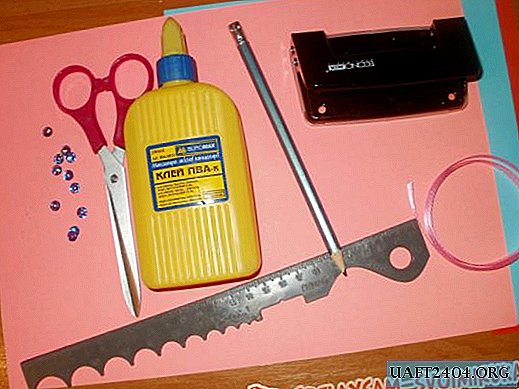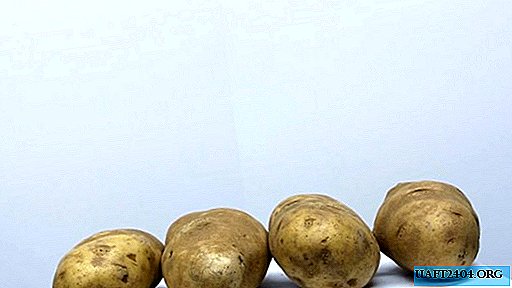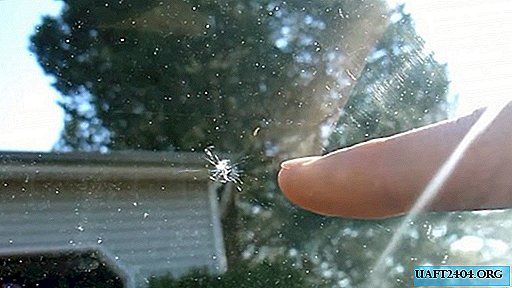Share
Pin
Tweet
Send
Share
Send
In Russia, the state-owned company RTRS is engaged in broadcasting. Since 2012, a government order has been recognized as the unified digital terrestrial television standard DVB-T2, a multiplex digital broadcasting standard. RTRS, as the only on-air operator, offers two multiplex packages (RTRS-1 and RTRS-2) for free viewing. All you need is a modern receiver-antenna, one of the options of which we propose to do today with our own hands.

The basis of this homemade product was taken by the development of the engineer Kharchenko K.P., who proposed similar antennas for the decimeter range (DSC), popular in the 90s of the last century. This is similar to aperture antennas, based on which the irradiator is in the form of a zigzag shape. The signal is accumulated by a flat reflector, which in size exceeds the vibrator by at least 20%.
A television signal is transmitted by waves with horizontal polarization. In a simplified form, such an antenna is two horizontal loop vibrators, connected together in parallel, but disconnected at the point of connection of the feeder (cable). Overall dimensions are given on the basis of an article by Kharchenko “Antenna of the DTSV band” and are calculated according to the proposed formulas. According to this technology, such antennas can be calculated even for a weak signal of about 500 MHz.




What you need to assemble the antenna
Materials:
- Barbecue grill;
- Aerosol paint for cars;
- Solvent or acetone;
- A set of drills for a conventional drill;
- Coaxial television cable - no more than 10 m;
- Half a meter of PVC pipe HV, diameter - 20 mm;
- Metal dowels for drywall;
- Copper wire for antenna vibrator, core diameter - 2-3.5 mm;
- Two thin metal plates.
Instruments:
- Powerful soldering iron at 100 watts;
- Screwdriver with nozzles;
- Hot glue gun;
- Pliers, hammer, nippers;
- Paint knife, tape measure, pencil.

Getting to the antenna
Making a vibrator frame
We measure the necessary length of the copper wire with a margin of about 1 cm. You can also use a copper or aluminum tube with a diameter of up to 12 mm.


We clean the copper core from isolation, and level it with a hammer on a hard surface. Mark the middle and make a 90 ° bend. Most accurately it will turn out to be done in a vice, slightly having tightened a copper vein and leveling it with a hammer.




According to our calculations, the sides of the squares will be 125 mm. We mark them with tape measure, and produce bends.








From one end, bite off a small fragment with side cutters, making the tip pointed at 45 °. After bending the second square, we carry out the same procedure, biting off the final end of the vein. Squares for this can be slightly straightened.




On the middle bends of the squares we achieve a distance of 10-12 mm. At the ends we make shallow cuts with a file. This will help us pull together both free ends, and fix them with a thin copper wire.





Using liquid rosin or flux, we tin the middle bends with a soldering iron. This must be done from all sides of the copper core of the vibrator.


We clean the coaxial cable 4-5 cm. We twist the braid or external conductor into a single wire, wrap it around one of the bends. Solder it to a copper core with a soldering iron.





We clean the insulation of the inner conductor, and also wrap it around the next bend of the frame. Solder it must be gently holding the insulation with pliers, because from the temperature it can simply shift from the center. First we heat the frame in the soldering zone, and only then the conductor itself.




We fix the coaxial cable supply with a nylon screed, degrease with solvent and isolate the soldering spots with hot glue using a gun. You can correct the defects of the resulting cast form of glue with a hairdryer.





Cooking reflector
We use an inexpensive barbecue net as a reflector or reflective screen. This is a good material, since even steel samples of such products are coated with a corrosion-resistant anodized coating, not to mention stainless steel. A heat exchanger from a modern refrigerator or a grill-dryer for dishes is also suitable. The main thing is that this element should not rust in the air if possible.
The reflector grille should be larger than the vibrator frame, but not necessarily symmetrical. We cut off the grips of the handle, they will be superfluous in our design.



We place the antenna frame in the middle of the reflector, and mark the places of its fasteners. For fixing, you can use two plates of any metal. We bend them along the lattice, and drill holes with a diameter of 5 mm.





Assemble the antenna
We cut two pieces of PVC pipe with a length of 75 mm, and screw them into the end of each screw, cutting off the protruding parts. For plasterboard dowels, break off the pointed ends, and screw them into the opposite end of the tubes.




We fasten both PVC racks to the strips on the reflector with screws. Tin the frame at the ends suitable for the racks for better heat transfer.



On racks, we note a height of 68 mm, and put it at risk. The ends of the frame are heated with a soldering iron, and soldered to the racks to the desired marks.



We fill the ends of the struts with hot glue, reliably fixing the vibrator frame at their base. We determine the position of the cable relative to the installation of the antenna, and fix it on the frame with nylon ties.



Since oxidation degrades the quality of the received signal, the reflector frame must be protected. Using spray paint is not at all difficult to do.


Since we have a lattice screen, it’s very easy to fix the finished antenna on the mast or pipe section using clamps. At the opposite end of the TV cable, we mount a standard TV connector F. We close it for insulation with heat-shrink cambric, and heat it up.






We twist the plug into the TV plug. We connect the cable to a digital television receiver or directly to a TV with a digital tuner, and enjoy free viewing of TV channels in digital quality.





If possible, such an antenna should be placed in the direction of the repeater. To enhance signal reception, the vibrator frame is supplemented with several "squares", and the reflector grid is complicated by horizontal bends.
Watch the DVB-T2 television antenna manufacturing video
Share
Pin
Tweet
Send
Share
Send











